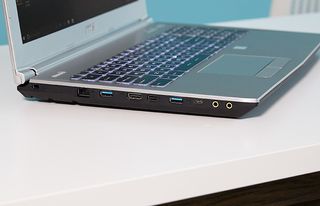Laptop Mag Verdict
The MSI PE60 Prestige packs solid gaming performance into a conservative chassis, but a dull screen holds it back.
Pros
- +
Comfortable keyboard
- +
Strong gaming and productivity performance
- +
Useful software
Cons
- -
Inaccurate display
- -
Not as sturdy as other aluminum notebooks
Why you can trust Laptop Mag
A low-end gaming rig in a conservative business laptop's clothing, MSI's PE60 Prestige ($1,199 to start; $1,249 as reviewed) looks equally at home in the boardroom and the living room. Thanks to its Nvidia GeForce GTX 1050 GPU and optional quad-core Core i7 CPU, this 15-inch laptop packs enough power to play the latest games, though not always at high settings. The screen isn't as accurate or as bright as some competitors, and although MSI opted for an aluminum chassis, it doesn't feel all that sturdy. But the Prestige's comfortable keyboard and useful software may be enough to win over entry-level gamers who also need a laptop for work.
Design
I wouldn't have guessed just by looking that the Prestige had gaming-ready power. It has a pedestrian design with a brushed-aluminum, silver lid (though it doesn't feel as sturdy as other aluminum laptops) featuring MSI's logo. From far away, I'd think it was a business laptop, and I can appreciate that it doesn't scream "Gaming!" with black and red stripes.

Lifting the lid reveals a 15.6-inch, 1080p display surrounded by a thick bezel. The plastic keyboard deck features the same pattern as the lid and houses an island-style, backlit keyboard complete with a number pad. The bottom of the notebook is made of simple black plastic.
At 5.4 pounds and 15.1 x 10.2 x 1.1 inches, it's a tad lighter than other entry-level gaming notebooks but roughly the same size. The Asus ROG Strix GL553VD is 15.1 x 10 x 1.2 inches and 5.6 pounds, while the Dell Inspiron 15 Gaming is 15.2 x 10.8 x 1 inches and 5.8 pounds.

There are more than enough ports for peripherals and extra storage flanking the sides of the Prestige. The left side boasts a lock slot, two USB 3.0 ports, an Ethernet jack, HDMI and mini DisplayPort outputs, USB Type-C, and headphone and microphone jacks. The right side is sparser, with a DVD drive, a USB 2.0 port and an SD card slot.
Display
The screen on the Prestige isn't terribly bright or accurate, which made the trailer for Spider-Man: Homecoming look dull and dark. The Spider-Man suit appeared more maroon than bright red as Spidey stopped masked foes from robbing a bank. I tried to turn up the brightness, hopingthe picture would become more luminous, but the screen was already at its maximum.

When I played Battlefield 1, the fire spouting from a German flamethrower started as a distinct orange. However, the parts of the flame that were supposed to be red and white had a slightly purple tinge. But the sticks and rocks in the muddy war zone were detailed and sharp, even though they were similar shades of brown.
The panel covers an excellent 133 percent of the sRGB color gamut, surpassing the mainstream average of 92 percent, the Strix (122 percent) and the Inspiron (a shameful 67 percent).
But those colors aren't very precise. The Prestige's display has a Delta-E color accuracy score of 5.1, which is much worse than the category average (2.6) and the Strix (1.6), but not as bad as the Dell Inspiron's shameful score of 12. (Lower numbers are better.)
The Prestige's display isn't very bright, either. It measured 192 nits on our light meter, falling well below the average (266 nits), the Inspiron (253 nits) and the Strix (269 nits).
Keyboard and Touchpad
The Prestige has a really comfy keyboard; it's like typing on a bouncy cloud (albeit a really responsive one). With its deep 1.8 millimeters of travel and 60 grams of force required to press the keys down, it never made me bottom out (hit the base hard).

I typed the low end of my average range, 107 words per minute, with a 2 percent error rate on the 10fastfingers.com typing test. I wish the keys would have popped up with a bit more force, but that didn't stop me from being fast and accurate.
Some of the shortcut placements are atypical. The display brightness and volume adjustment functions are situated on the arrow keys rather than the function row, which I could get used to but initially found distracting. The backlight keys are tucked away on the number pad, and although I understand the reasoning behind removing the left Windows key to keep it out of the way while gaming, I wish it were there with an option to disable it.
The 4.2 x 2.3-inch touchpad is roomy and smooth, with two clicky buttons, and I two-finger scrolled around the web without any issues.
Audio
The Prestige's speakers produce lifeless sound. When I listened to Blue October's "Drilled A Wire Through My Cheek," the guitars were quiet, and the vocals were strained. The bass, however, was deep, to a point where I felt it was suppressing the rest of the track. The song was too quiet, and only filled the room during the screamy chorus.
I opened up the preloaded Nahimic 2 audio app and adjusted the sliders for treble and vocal clarity, which made the song more palatable, but still strained.
When I played Battlefield 1, the game was crystal clear. The pained screams and cries as soldiers were gunned down around me were horrifying, and there was a little punch to every gunshot; I only wished it all had been a little louder. I opened Nahimic 2 and switched to the preset for first-person-shooter video games, and I got the volume I was looking for. The bullets thudded harder, but the soldiers' voices sounded rougher and were harder to understand.
Gaming and Graphics
The Prestige's Nvidia GeForce GTX 1050 graphics will play just about any game, though not always at the highest settings. I managed to play Battlefield 1 at 1080p and high settings at a smooth 47 frames per second as I gunned down German soldiers with a machine gun in World War I. When I got bold and switched to ultra settings, it was still playable, at 38 fps, though there was some pretty noticeable screen tearing.
On our budget gaming benchmark, the Prestige played Rise of the Tomb Raider on high settings with SMAA anti-aliasing at 44 fps. It's smoother than the mainstream average (36 fps) and the Strix GTX 1050, 38 fps), but slightly behind the Inspiron (GTX 1050, 49 fps).

When we ran the Hitman benchmark (1920 x 1080 on ultra settings), the Prestige played the game at 39 fps, which isn't as smooth as the average (53 fps, but this includes gaming notebooks with GTX 1060 or 1070 GPUs) but better than the Inspiron (35 fps) and the Strix (30 fps).
Metro: Last Light bested the machines with GTX 1050 GPUs. With the settings on high at 1080p, the Prestige played the game at 26 fps, falling below our 30-fps playability threshold. The Strix reached 23 fps, and the Inspiron hit 29 fps, but neither hit the 33-fps average.
Performance
With a 2.8-GHz Intel Core i7-7700HQ CPU; 16GB of RAM; a 128GB NVMe PCIe solid-state drive; and a 1TB, 7,200-rpm HDD, the Prestige is primed for juggling your work. I had 30 tabs open in Chrome, including one streaming a 1080p episode of "The Daily Show with Trevor Noah" without any sign of lag at all.
The notebook earned a score of 12,678 on the Geekbench 4 overall performance test, beating the mainstream average of 10,801 and just surpassing the Strix's (Core i7-7700HQ ) 12,253. The Inspiron (Core i5-7300HQ) was the worst in the field, scoring 10,363.

The Prestige copied 4.97GB of files in 22 seconds, for an effective transfer rate of 231.3 megabytes per second. That's speedier than the average (168 MBps), Inspiron (106 MBps) and Strix (94.2 MBps).
It took MSI's notebook 3 minutes and 39 seconds to pair 20,000 names and addresses in our OpenOffice Spreadsheet macro test. Though that beats the 4:20 mainstream average, both the Strix (3:31) and the Inspiron (3:37) were a little bit quicker.
Battery Life
The Prestige can't go very long without a charge. It lasted just 4 hours and 13 minutes on the Laptop Mag Battery Test (continuous browsing over Wi-Fi). While that's longer than the Strix (3:41), it's lower than the mainstream category average (6:47) and the Inspiron's whopping 11:14.
MORE: Laptops with the Longest Battery Life
Webcam
The Prestige's 720p webcam produces muddy, pixelated images. Shots that I took at my desk were out of focus, so my face appeared extremely blurry. I was able to see the jagged pixel outline on my headphones, and the lights behind me were completely blown out.
Heat
During regular use, the Prestige was nice and cool. After we streamed HD video from YouTube for 15 minutes, it measured 92 degrees Fahrenheit on the bottom, 85 degrees between the G and H keys, and 89 degrees on the touchpad.
Things got a tad steamier when I played Battlefield 1. The bottom of the notebook climbed to 104 degrees, the center of the keyboard reached 100 degrees and the touchpad was 96.5 degrees.
Software and Warranty
MSI packed the Prestige with a mix of its own gaming software, multimedia utilities and a whole bunch of bloat.
Most notable is MSI's Dragon Center, a hub for monitoring system performance, customizing settings and getting technical support. MSI's True Color lets you change the screen's color temperature to reduce blue light, as well as tweak preset options for gaming, designing and the office.
You also get your fair share of multimedia apps, including CyberLink PowerDVD for DVD playback, Magix Music Maker Silver and Photo Manager 16.
And then there's the bloat: Minecraft, Twitter, Facebook, Royal Revolt 2, Candy Crush Soda Saga, and Houzz.
MSI sells the PE60 Prestige with a two-year warranty. See how MSI did on our Tech Support Showdown and Best and Worst Brands ranking.
Configurations
Our review configuration of the MSI PE60 Prestige costs $1,249 and comes with a 2.8-GHz Intel Core i7-7700HQ CPU, 16GB of RAM, an Nvidia GeForce GTX 1050 GPU with 2GB of VRAM (it falls back to integrated Intel HD Graphics 630 when you don't need the power), a 128GB NVMe PCIe SSD and a 1TB, 7,200-rpm HDD.
For $1,199, you can get the same laptop, but with a dual-core Intel Core i7-7500U CPU instead of the quad-core processor in our review configuration.
Bottom Line
With its silver, professional stylings, the MSI PE60 Prestige might not look like a powerful gaming or multimedia laptop, but that's its most obvious use. The combination of an Intel Core i7 CPU and Nvidia GeForce GTX 1050 graphics is more than enough to play most games, albeit not at their highest settings.
But the display leaves a lot to be desired, as its colors aren't accurate and can sometimes skew dark or a little purple. If you want something with a better screen and don't mind a laptop that screams "I'm a gaming PC," check out the $1,099 Asus ROG Strix GL553VD, which has a more vivid panel and a comfortable keyboard, and costs hundreds less.
Those who prefer to use their laptop in a more professional setting and appreciate MSI's applications for gaming and audio should give the PE60 a look, even if that look is a little purple.
MSI PE60 Prestige 2017 Specs
| Bluetooth | Bluetooth 4.2 |
| Brand | MSI |
| CPU | 2.8-GHz Intel Core i7-7700HQ CPU |
| Card Slots | SD memory reader |
| Company Website | msi.com |
| Display Size | 15.6 |
| Graphics Card | Nvidia GeForce GTX 1050 GPU 2GB VRAM |
| Hard Drive Size | 128GB |
| Hard Drive Type | NVMe M.2 PCI-e SSD |
| Highest Available Resolution | 1920 x 1080 |
| Native Resolution | 1920x1080 |
| Operating System | Windows 10 Pro |
| Optical Drive | DVD SuperMultiDrive |
| Ports (excluding USB) | Mini DisplayPort, USB 2.0, USB 3.0, HDMI-out, USB Type-C, Headphone, Headset, Kensington Lock |
| RAM | 16GB |
| RAM Upgradable to | 32GB |
| Secondary Hard Drive Size | 1TB |
| Secondary Hard Drive Speed | 5,400rpm |
| Secondary Hard Drive Type | HDD |
| Size | 15.1 x 10.2 x 1.1 inches |
| Touchpad Size | 4.2 x 2.3 inches |
| USB Ports | 4 |
| Video Memory | 2GB |
| Warranty/Support | 2 years |
| Weight | 5.4 pounds |
| Wi-Fi | 802.11ac |
| Wi-Fi Model | 802.11ac Wi-Fi + Bluetooth v4.2 |
